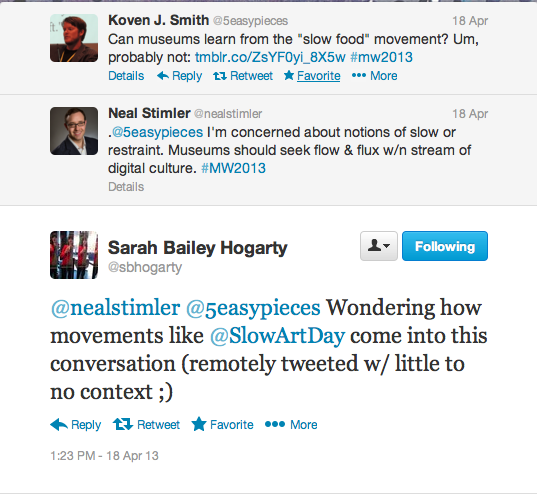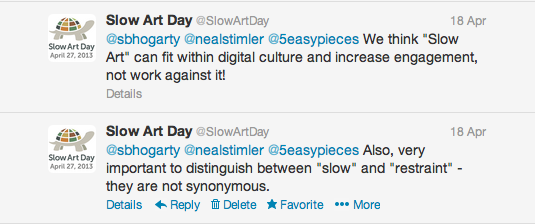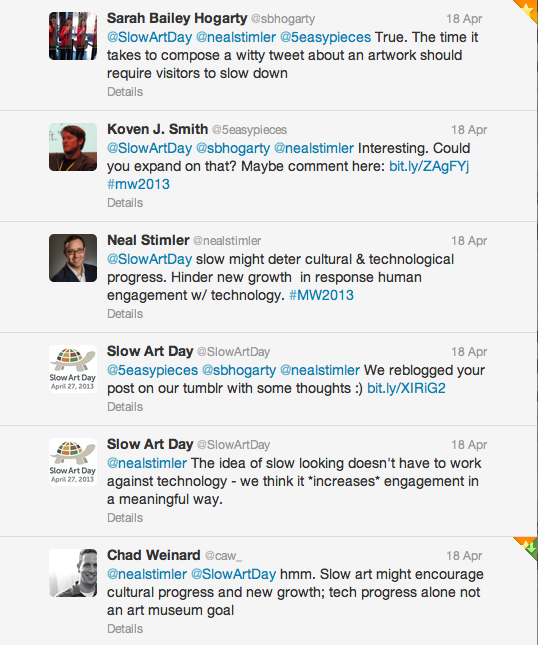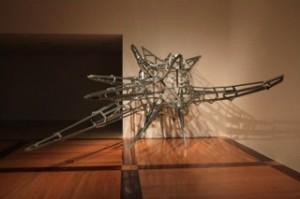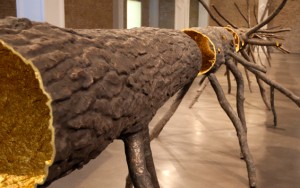Slow Art Day has asked its 2013 college interns to write short summaries of their own experiences looking slowly at artworks of their choosing.

I went to the Modern Art Museum to look slowly at Mark Bradford’s “Kingdom Day,” a mixed media collage covering roughly 38’x 38’. Mark Bradford is one of my favorite artists so I really wanted to dive into this piece…and just look.
This piece overwhelms pleasantly in its rich detail and intricacy. It requires looking both at a distance and up close to gain a full sense of it. Up close, I can see the texture of the lines carved into the layers of what looks to be thick sheet of paper or cardboard, that are either painted over, scratched through, or exposed in tiny bits here and there to give hints of its original appearance.
After looking up close, I move to about 10 feet away where I can see the whole thing at once. In this view, I can see larger patterns in the lines scratched into the surface, and I am able to read the four individual canvases that were put together as pieces of a narrative, each telling a different story.
I naturally begin to move along the piece in this way, seeing each canvas as a series of messages. The first canvas has the word ‘Kingdom’ at the top. The engraved lines look like a satellite view of a city, with tight grids and patches that mimick the patterns of streets and neighborhoods. There is a black patch that looked like the shape of an angel flying over, which gives it an ominous feel, like the city was being haunted. The next two canvases are more sinewy and abstract; the grids become more complex and intertwined, and are less representative of a city. I can make out faces behind all of the lines, making me think of people in jail behind bars. The ravaged surface and destroyed parts of advertisements remind me of corruption or war.
I get lost in the bright colors, lines, and layers that overwhelmed my eye. I move to the last canvas. I notice the word ‘Day’ at the top, both framing the piece and reflecting on its title. This canvas has the most pink in it, which suggests a dawn or a new hope to me. The lines once again become more orderly and city-like, and an arrangement of black shapes behind the lines look like a city skyline against the pink background. I get an immediate sense of optimism despite the ravaged appearance and various allusions to crime, corruption, or war. For me, the piece seems to resolve in that last canvas, but I can look back on the first three and still feel the energy and uneasiness through all of the lines, layers, and faces.
When I am satisfied with looking at the piece, I look down at my watch and discover that I have been gazing for 18 minutes. 18 minutes? I am amazed at how much the time had flown past, yet how much I have experienced and thought about compared to what I would have seen from just a cursory glance. I feel so much more enriched than I normally do from looking at art – and I normally love looking at art. The effect of just slowing down and focusing on the art is incredible, and similar I think now to the feeling of meditation.
I will not only continue working on Slow Art Day as an intern, but will definitely be doing some more slow art looking in the future, and I encourage you to do the same. And if you are in the Dallas/Ft. Worth area soon, go to the Modern Art Museum and look slowly at this wonderful piece by Mark Bradford.
[Mark Bradford’s Kingdom Day (2010) was viewed in the Fort Worth’s Modern Art Museum as a part of their permanent collection.]
-Adrienne Parker, University of Texas

